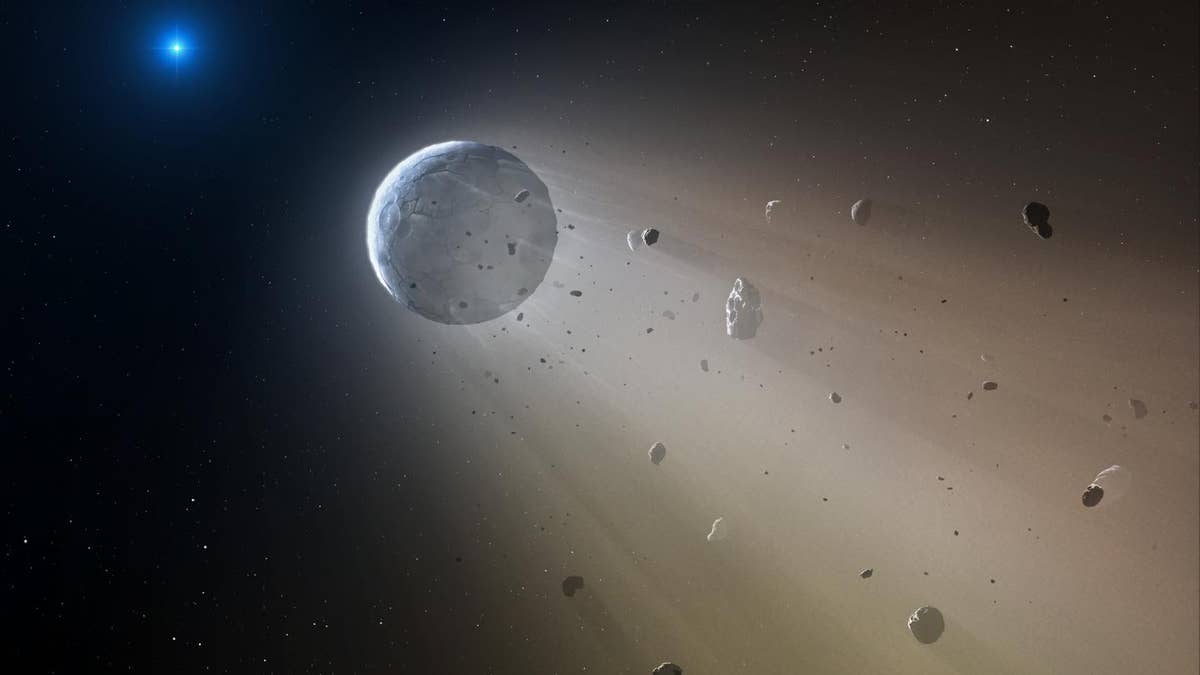
Ceres-Like Asteroid Artist's Conception (Mark A. Garlick)
NASA announced this week it would return to the Moon and eventually head toward Mars with the help of commercial partners for the first time, adding to the level of excitement about space exploration and its potential socioeconomic benefits.
Some analysts believe the space economy could be worth $1 trillion in a few decades — and America stands to capture a significant portion of that.
In a note to investors earlier this week, Morgan Stanley analysts estimated the space economy will be worth more than $1 trillion by the year 2040 and could be worth as much as $1.7 trillion if all goes as planned.
Much of the benefits will come from satellite broadband, of which California-based SpaceX has already started working on. In February 2018, the Elon Musk-led company received approval from the Federal Communications Commission (FCC) to build a satellite broadband network, providing high-speed network to all corners of the Earth. On November 15, the company received approval to make its eventual network even larger, getting the OK to launch more than 7,500 Internet-delivery satellites into low-Earth orbit, on top of the already approved 4,000 satellites, Fox 47 reported.
ELON MUSK THINKS HUMANS WILL HAVE TO MERGE WITH MACHINES TO OVERCOME THEIR 'EXISTENTIAL THREAT'
"Think of the innovation that has come from the Internet that we would not have been able to model in the 1990s," the analysts wrote in their note, while cautioning that if there is less emphasis on broadband, the space economy could be worth significantly less than $1 trillion.
The analysts mentioned several areas where the space economy could see booms: consumer services (including TV, radio and broadband connections), satellite services, ground equipment, consumer navigation, consumer and networking equipment, satellite manufacturing and launch and what it calls the "non satellite industry."
In May, SpaceX successfully launched the first satellite from Bangladesh into orbit, which will allow Internet access in all corners of the country.
While the $1 trillion figure is eye-opening, it is nothing to say of the potential for mining asteroids, which some analysts could be worth multiple trillions of dollars. In 2017, one analyst from Goldman Sachs theorized that one asteroid could have as much as $50 billion worth of platinum, as well as water and other precious resources.
Water and platinum group metals that are abundant on asteroids are highly disruptive from a technological and economic standpoint," Poponak wrote in an investor note. "According to a 2012 Reuters interview with Planetary Resources, a single asteroid the size of a football field could contain $25bn- $50bn worth of platinum," the analyst added.
NASA has said for several years, going back to 2013, that it intends to mine asteroids as well.
Socioeconomic benefits
While announcing the nine companies – including Lockheed Martin and New Jersey-based Orbit Beyond – that will help take NASA astronauts to the Moon and beyond, NASA administrator Jim Bridenstine stressed that this would not be like past initiatives that have previously failed.
Bridenstine stated NASA was "spreading the risk" and "lowering the cost with multiple commercial partners." "This is not going to be Lucy and the football again," Bridenstine said. "We're not going to plan to go to the Moon and not go to the Moon. We have more partners than ever before and their level of excitement is higher than it's ever been."
The NASA administrator likened it to venture capital — "we're taking shots on goal," he said, adding that the space agency would have some risk, but a greater reward because of its commercial partners. "We want medium-class landers, we want large-class landers and we want human-class landers. We also want to get there fast."
In addition, Bridenstine, also a former congressman from Oklahoma, said NASA would be conducting scientific experiments on the surface of the Moon, taking heed from the scientific community. "We believe there is a lot of amazing science we can do on the surface of the Moon," Bridenstine said during the presentation.
Thomas Zurbuchen, associate administrator for NASA’s Science Mission Directorate, said there is water on the Moon and the upcoming scientific experiments will help humanity learn how to use these resources to further science.
The Trump administration has cited Moon missions a key element of the 2019 NASA budget. President Trump wants U.S. astronauts to return to the Moon as a foundation for future Mars missions.
SPACEX REVEALS YUSAKU MAEZAW WILL FLY 'AROUND THE MOON' IN HISTORIC ANNOUNCEMENT
Heady times for the final frontier
2018 has been a monumental year for space exploration, as it included the February launch of SpaceX's Falcon Heavy rocket and NASA's return to Mars earlier this week with the Mars InSight Lander.
Other events include September's announcement that SpaceX will fly Japanese billionaire Yusaku Maezawa around the Moon in 2023, becoming the first private passenger aboard the company's renamed Starship launch vehicle (it was previously known as the Big Falcon Rocket), as well as the Trump administration ordering the establishment of the Space Force as the sixth branch of the military.
Initially, the idea puzzled many on both sides of the aisle but recently gained the backing of some luminaries, such as Neil deGrasse Tyson and the aforementioned Musk.
In August, Vice President Pence revealed the Trump administration wants to create the “Space Force” by 2020.
Follow Chris Ciaccia on Twitter @Chris_Ciaccia




















